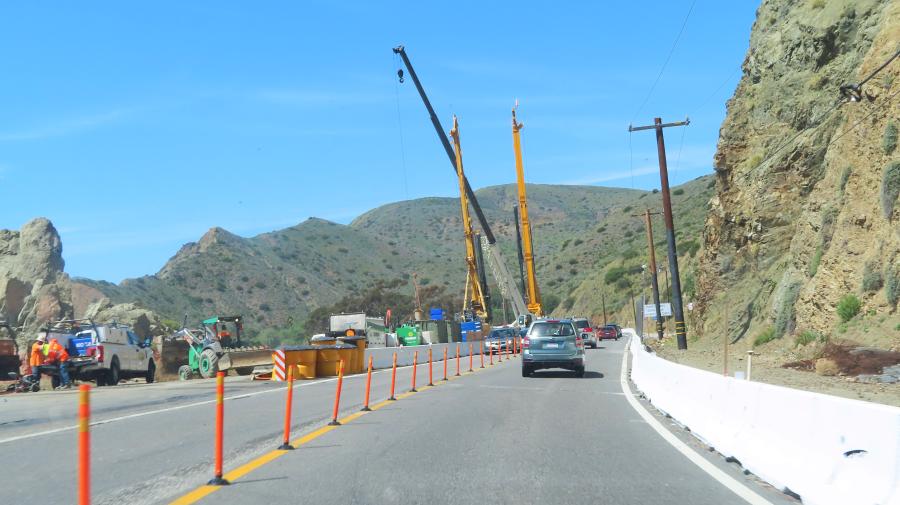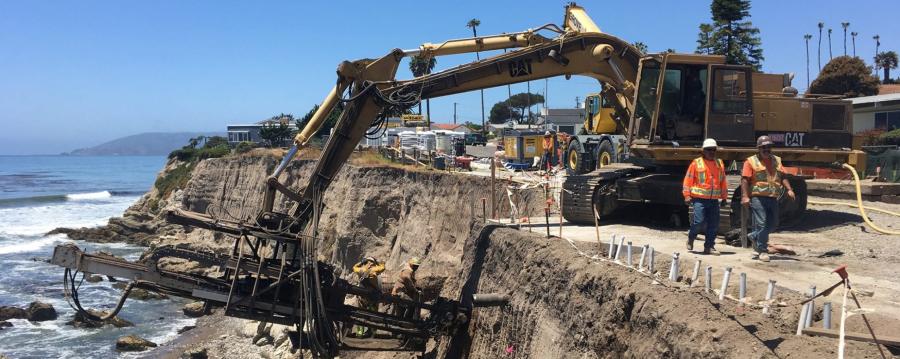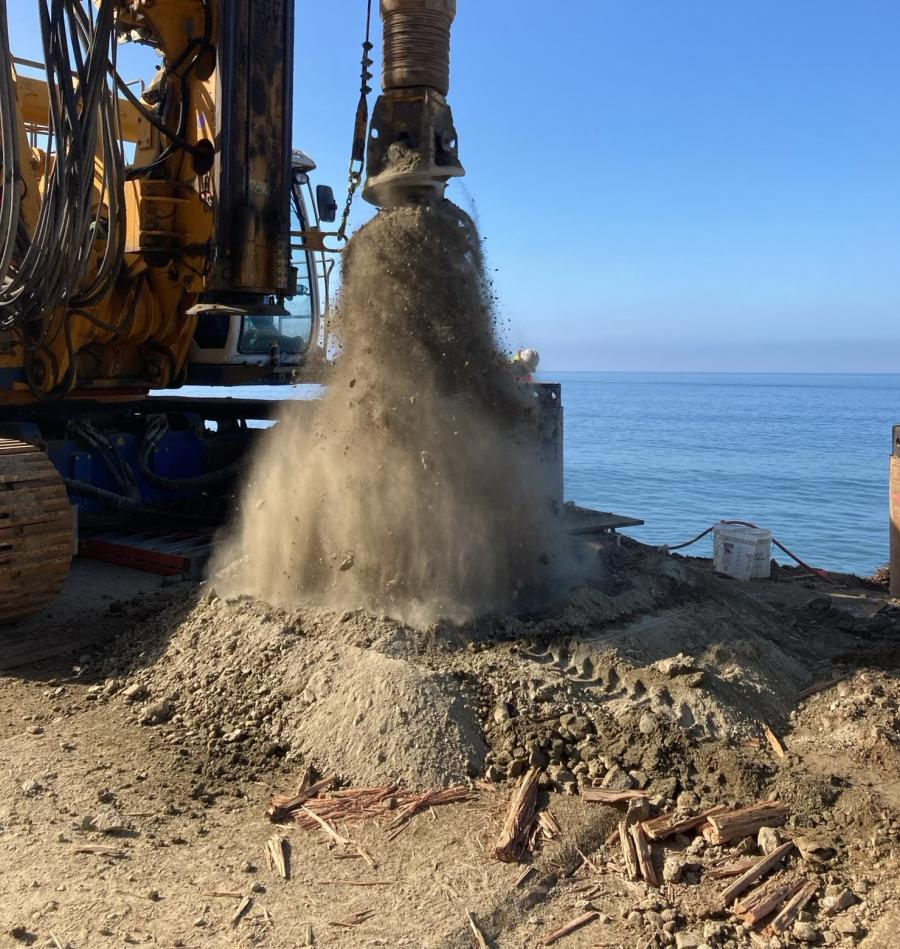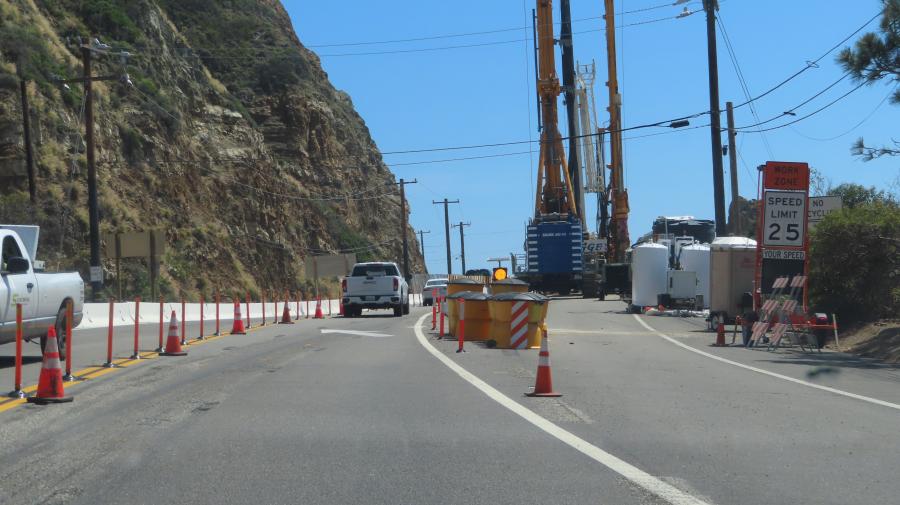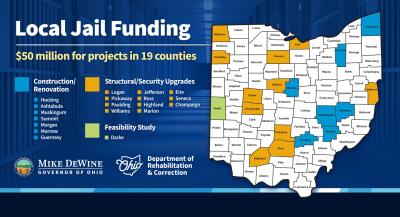(Photo courtesy of Caltrans)
The California Department of Transportation is spending $51 million to construct two secant (retaining) walls to restore eroded slopes on the coastal side of the Pacific Coast Highway (PCH, Route 1) south of Point Mugu State Park in Ventura County.
The work, being done via a joint venture consisting of Flatiron and Drill Tech Drilling & Shoring Inc., began in September 2021 and should be completed in the spring 2023.
The project will alleviate future undermining of slopes due to severe erosion and possible failure of the roadway itself. The work is closing a 1,000-ft. long stretch of the right southbound shoulder, reducing the PCH to one lane in both directions.
The work zone is between the state park and Sycamore Canyon Road. One wall is located at Post Mile (PM) 4.0 and the other is at PM 4.2.
"The goal is to provide permanent restoration to the eroded slopes — the project area is prone to erosion and needs adequate slope protection," said Jim Medina, public information officer, Caltrans, District 7. "The secant wall at PM 4.0 is about 600 feet long. The second secant wall at PM 4.2 is about 200 feet long. The project is needed because there has been accelerated structural undermining of the slope due to severe surf erosion, which has resulted in cracks and displacements of the roadway shoulder."
Project Challenges
The location of the project has made for some challenging obstacles for crews to overcome.
"It took a couple of weeks to deliver the equipment and set up the two large drills and crane," said Mark Hood, structures manager of Drill Tech Drilling & Shoring Inc. "There are several locations across the two walls where the existing slope is not stable and has washed out. Therefore the drills and the crane are staged on steel plates. Both walls are secant pile walls wherein the drilled shaft overlap each other. Primary piles [30-in. diameter] are drilled first, have no reinforcing steel and are backfilled with concrete only. The primary piles range from 40 to 63 feet deep. The secondary piles (54-in. and 60-in. diameter] are drilled after primary piles and overlap the primary piles.
"W36 steel beams are placed in the secondary pile shafts, then they are backfilled with concrete," he added. "The secondary piles range in depths of 40 to 95 feet. The tips [bottom] of the secondary piles are pounded into the bedrock up to 16 feet. Sea water is encountered at about 35 to 50 feet below the roadway [roadway gradually slopes upward]. There are 133 primary piles and 139 secondary piles across two walls. All piles are being installed with full depth, temporary casing. We have been able to complete primary piles at a rate of about 1.5 per shift. The secondary piles take two shifts to complete one."
The concrete is being batched and delivered by Associated Ready Mix out of its Oxnard plant. The plans and specifications require a minimum 4,000 psi concrete for a corrosive environment, meaning it is a mixture containing additives to handle corrosion and the sea water environment.
"Along the top of both secant pile walls, a 7-foot tall by 2.5-foot thick concrete waler will be constructed across the top portion of the piles," said Hood. "Through the waler, 123 6-inch diameter horizontal ground anchors, up to 55 feet long, will be installed. On top of the secant pile walls, a concrete barrier slab and concrete barrier rail will be constructed."
Safety measures are a given due to the terrain.
"Much of the work is adjacent to a steep bluff," said Hood, "therefore workers need to be tied off and the heavy equipment staged on steel plates."
The weather also has been a factor — a heavy rainfall in December 2021 washed away a portion of the slope at Wall 1 encroaching close to the secant pile alignment.
Many pieces of heavy equipment are being utilized, such as a JD 210 skip loader (handle spoils), JLG 9,000 lbs./12,000 lbs. extending boom forklifts, 20,000 gal. open holding tanks (water from shaft and drilling slurry), a 2,000-gal. water truck; Ingersoll Rand 400cfm air compressor and 500-gal. water buffalos as well as other pieces.
"Almost all the equipment, is owned by Drill Tech," said Hood. "The two drills being used are a Bauer BG30 and BG45. The crane being used is a Terex 110 ton rough terrain crane. An oscillator is being utilized to pull the casing of the secondary piles during the concrete backfill. A Schwing 32M boom pump is used to place the concrete."
"Due to the tight available working area, the equipment set-up, staging and utilization has to be carefully managed," said Tim Pitcher, Flatiron's project manager. "Staging of equipment has to be managed for concrete and beam deliveries. Flatiron-Drill Tech created an equipment and material staging and delivery logistics plan prior to beginning the work."
The JV management also includes Senior Project Manager Martin Pettee, Project Engineer Melissa Thurber, Field Engineer Luis Maldonado and Superintendents Rex Cochran, Don Sheresh and Oscar Arellano.
"We are able to work great together with no conflicts," said Pitcher.
"The crews are working hard and efficiently working 10 to 12 hour shifts Monday through Friday and some Saturday work," said Hood.
The drilling and excavation work, so far, has generated approximately 2,000 tons of earth and rock combined.
"The drilled materials are too sandy and rocky to be reused," said Hood. "We intend to reuse the roadway excavation material for future backfill along the face of the wall. Any material that can be recycled is being recycled."
Busy days have eight to 10 JV employees on-site. In September, Marvella, a rebar subcontractor, is scheduled to arrive.
"The teeth on the tooling have to be replaced almost daily and the tooling requires weekly hardfacing to prevent them from wearing through," said Hood. "A mechanic comes through the project weekly to maintain the equipment. Equipment maintenance has been fairly routine. We have not noticed exposure to salt environment affecting the equipment thus far."
The JV partners purchase and rent equipment from local and regional dealerships.
"Bauer Equipment America [Livermore, Calif.] provides parts and components for the two drills, as well the casing and tooling including replacement teeth," said Hood. "Drill Tech has had a working relationship with Bauer for about 20 years."
Project Information
The lanes will be a shared roadway with bicyclists, noted the project web page. The speed limit in the work zone will be reduced to 25 miles per hour. There will be intermittent lane closures as needed for public safety. Motorists can expect delays. This configuration will be for the duration of the project. Cranes and heavy equipment will be visible on the coastal side.
"Construction will occur day and night as needed, Monday through Saturday," it added. "Construction activities will generate noise, vibrations and dust. The work zone is not located near residential or commercial areas."
As work space is tight, traffic lanes are being shifted toward the mountainside to create staging space for construction equipment.
"To provide drivers with protection against falling rocks along the shoulder, cable net mesh was installed on the mountain prior to construction," said Medina.
The work zones are separated from traffic by a K-rail barriers. Some of the coastal areas are larger than others, which means that it is more difficult to place equipment. Furthermore, while some of the slopes are gentle, there are some spots that are steep and the shoreline has some large rocks along it. CEG
Irwin Rapoport
A journalist who started his career at a weekly community newspaper, Irwin Rapoport has written about construction and architecture for more than 15 years, as well as a variety of other subjects, such as recycling, environmental issues, business supply chains, property development, pulp and paper, agriculture, solar power and energy, and education. Getting the story right and illustrating the hard work and professionalism that goes into completing road, bridge, and building projects is important to him. A key element of his construction articles is to provide readers with an opportunity to see how general contractors and departments of transportation complete their projects and address challenges so that lessons learned can be shared with a wider audience.
Rapoport has a BA in History and a Minor in Political Science from Concordia University. His hobbies include hiking, birding, cycling, reading, going to concerts and plays, hanging out with friends and family, and architecture. He is keen to one day write an MA thesis on military and economic planning by the Great Powers prior to the start of the First World War.
Read more from Irwin Rapoport here.
Today's top stories



